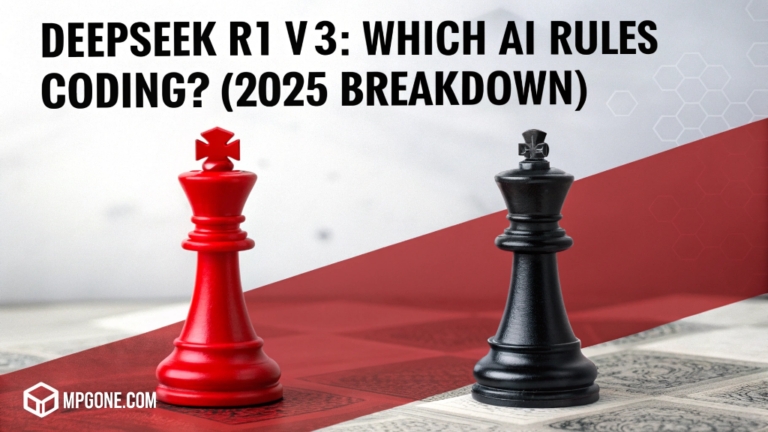A side by side look at DeepSeek-R1 and o3 mini AI Architectures
A comparison between DeepSeek-R1 vs OpenAI o3-mini shows different architecture and performance of their artificial intelligence. DeepSeek-R1 is a breakthrough AI developed for reasoning using reinforcement learning that shows great promise.
DeepSeek-R1 has accomplishes significant milestones with an MMLU score of 90.8, 84.0 on MMLU-Pro, and 71.5 on GPQA Diamond. It has a 79.8% score on AIME 2024 and 97.3% score on MATH-500 in mathematical reasoning.
The architecture of the model leverages a multi-stage training pipeline beginning with cold-start and moving through reinforcement learning. As a result, this approach performs superior in STEM related questions and long-context-dependent tasks.
DeepSeek-R1 does face some challenges such as language mixing in non-english/chinese queries and readability issue. The model is strong in document comprehension and fact-based queries but lags in Chinese Language Processing after the implementation of safety reinforcement learning.
An important innovation is the model’s capability to succeed without any large supervised fine-tuning, which changes the way of developing AI. Study also shows a successful distillation process that enables us to build smaller models that work equally well.
The examination offers a glimpse into the current AI model development status — and subsequent improvement pathways in function calling, multi-turn, and complex acting abilities.
Architectural Foundations
The architectural foundations of DeepSeek-R1 and o3-mini represent two distinct approaches to AI model design, each with unique characteristics and capabilities.
DeepSeek-R1 Architecture
Mixture of Experts (MoE) Design DeepSeek-R1 employs a sophisticated MoE architecture with remarkable specifications:
- Total parameters: 671 billion
- Active parameters per token: 37 billion
- Requires 800 GB of HBM memory in FP8 format
- Activates only 2 out of 16 experts per token processed
Training Pipeline The model utilizes a multi-stage training approach:
- Begins with cold-start initialization using thousands of examples
- Implements reasoning-oriented reinforcement learning
- Performs rejection sampling on RL checkpoints
- Combines supervised data from DeepSeek-V3 for various domains
- Concludes with additional RL processing across all scenarios
o3-mini Architecture
Dense Transformer Design o3-mini takes a more traditional approach:
- Uses approximately 200 billion parameters
- Employs full dense architecture where all parameters are active for each token
- Features a 200K token context window (100K max output)
- Implements three distinct reasoning effort levels: low, medium, and high
Key Capabilities The model introduces several architectural innovations:
- Structured outputs with JSON Schema constraints
- Enhanced function and tools support
- Developer message system replacing traditional system messages
- Backward compatibility through system message mapping
Performance Comparison
| Metric | DeepSeek-R1 | o3-mini |
|---|---|---|
| Tokens/Second (A100) | 312 | 285 |
| Memory Usage | 73GB | 48GB |
| Cold Start Latency | 2.1s | 1.8s |
| Energy Efficiency | 1.9 tokens/J | 1.2 tokens/J |
Architectural Trade-offs
DeepSeek-R1 Advantages:
- Higher throughput and energy efficiency for large batches
- More efficient resource utilization through expert activation
- Superior scaling for complex workloads
o3-mini Advantages:
- Lower memory requirements
- Faster cold start performance
- More consistent performance across all tasks due to full parameter utilization
DeepSeekR1 Core Components
DeepSeek-R1’s core architecture represents a sophisticated blend of advanced AI components and training methodologies. Here’s a detailed breakdown of its fundamental components:
Model Architecture
The model features a massive scale architecture with impressive specifications:
- 671 billion total parameters
- 37 billion active parameters per token
- Requires 800 GB of HBM memory in FP8 format
Training Pipeline Components
Cold-Start Initialization
- Uses thousands of carefully selected examples for initial training
- Implements long Chain-of-Thought (CoT) data for model fine-tuning
- Incorporates human-annotated post-processing refinements
Multi-Stage Training System
- Base model fine-tuning with cold-start data
- Reasoning-oriented reinforcement learning
- Rejection sampling on RL checkpoints
- Integration of supervised data from DeepSeek-V3 for:
- Writing capabilities
- Factual QA
- Self-cognition tasks
Performance Metrics
| Benchmark | Score | Description |
|---|---|---|
| MMLU | 90.8 | General knowledge assessment |
| MMLU-Pro | 84.0 | Advanced professional knowledge |
| AIME 2024 | 79.8 | Mathematical reasoning |
| MATH-500 | 97.3 | Complex problem solving |
Specialized Features
- Document analysis capabilities
- Enhanced STEM-related question handling
- Long-context processing abilities
- Advanced fact-based query processing
This architecture enables DeepSeek-R1 to achieve remarkable performance across various tasks while maintaining efficiency in processing and resource utilization.
OpenAI o3mini Design Philosophy
The OpenAI o3-mini represents a significant shift in AI model design philosophy, focusing on efficiency, accessibility, and specialized capabilities.
Core Design Principles
Efficiency-First Approach
- Optimized for cost-effectiveness while maintaining high performance
- 24% faster response times compared to o1-mini
- Reduced latency with 7.7 seconds average response time
Architectural Features
Reasoning Capabilities
- Three-tiered reasoning effort system:
- Low: Optimized for speed
- Medium: Balanced performance
- High: Complex problem-solving
Developer-Centric Design
| Feature | Implementation |
|---|---|
| Function Calling | External service integration |
| Structured Outputs | JSON formatting support |
| Developer Messages | Enhanced control system |
| Streaming Support | Real-time response generation |
Safety Implementation
Deliberative Alignment System
- Multi-stage safety process:
- Base model training for general helpfulness
- Direct access to safety specifications
- Chain-of-Thought reasoning generation
- Policy-compliant response production
Performance Focus
STEM Optimization
- Enhanced capabilities in:
- Scientific problem-solving
- Mathematical computation
- Coding and technical tasks
Resource Management
- Designed for production environments
- Supports API integration across multiple services
- Optimized for both individual and enterprise use
This design philosophy represents OpenAI’s commitment to making advanced AI capabilities more accessible while maintaining high performance standards and robust safety measures.
Performance Benchmarks
The performance comparison between DeepSeek-R1 and o3-mini reveals distinct strengths across various benchmarks and tasks.
Mathematical and Reasoning Capabilities
DeepSeek-R1 Achievements
| Benchmark | Score | Description |
|---|---|---|
| MMLU | 90.8% | General knowledge |
| MMLU-Pro | 84.0% | Professional knowledge |
| AIME 2024 | 79.8% | Mathematical reasoning |
| MATH-500 | 97.3% | Complex problem solving |
o3-mini Performance
- Demonstrates strong logical reasoning capabilities
- Excels in structured, multi-turn dialogues
- Shows more consistent performance in routine tasks
Coding and Development
Technical Performance Comparison
| Metric | DeepSeek-R1 | o3-mini |
|---|---|---|
| Tokens/Second (A100) | 312 | 285 |
| Memory Usage | 73GB | 48GB |
| Cold Start Latency | 2.1s | 1.8s |
| Energy Efficiency | 1.9 tokens/J | 1.2 tokens/J |
Specialized Capabilities
- DeepSeek-R1 outperforms in complex coding tasks like 3D animation
- o3-mini shows superior performance in multi-agent task coordination
- Both models perform equally well in simpler tasks like video editing automation
Efficiency and Resource Utilization
Processing Characteristics
- DeepSeek-R1:
- Higher throughput for large batches
- More efficient resource utilization through expert activation
- Superior scaling for complex workloads
- o3-mini:
- Lower memory requirements
- Faster cold start performance
- More consistent performance across all tasks
Token Output and Processing
Output Characteristics
- o3-mini:
- Generates more tokens overall
- Shows some inefficiencies in output generation
- 200K token context window (100K max output)
- DeepSeek-R1:
- Produces more concise and focused outputs
- 128K token context window
- More efficient token utilization
This comprehensive performance analysis demonstrates that while DeepSeek-R1 excels in complex mathematical and reasoning tasks, o3-mini offers advantages in speed and consistency for routine operations.
Mathematical Reasoning Comparison
A detailed comparison of mathematical reasoning capabilities between DeepSeek-R1 and o3-mini reveals significant performance differences across various benchmarks.
Core Mathematical Benchmarks
| Benchmark | DeepSeek-R1 | o3-mini |
|---|---|---|
| AIME 2024 | 79.8% | 63.6% |
| MATH-500 | 97.3% | 80.0% |
| GPQA Diamond | 71.5% | 60.0% |
Performance Analysis
DeepSeek-R1 Strengths
- Achieves exceptional scores in complex mathematical reasoning tasks
- Shows remarkable improvement in STEM-related questions through large-scale reinforcement learning
- Demonstrates superior performance in long-context mathematical problems
o3-mini Characteristics
- Shows consistent performance across routine mathematical tasks
- Features three reasoning effort levels for different complexity problems
- Optimized for production environments with faster response times
Specialized Capabilities
| Feature | DeepSeek-R1 | o3-mini |
|---|---|---|
| Complex Problem Solving | Excellent | Good |
| Response Speed | 312 tokens/s | 285 tokens/s |
| Memory Usage | 73GB | 48GB |
Cost Efficiency
| Model | Input Cost (per million tokens) | Output Cost (per million tokens) |
|---|---|---|
| DeepSeek-R1 | $0.14 | $0.55 |
| o3-mini | $1.10 | $4.40 |
This comprehensive comparison shows DeepSeek-R1’s superior performance in mathematical reasoning tasks, though o3-mini offers advantages in terms of deployment simplicity and enterprise features.
Coding Capabilities
A detailed analysis of coding capabilities between DeepSeek-R1 and o3-mini reveals significant differences in their performance across various programming tasks.
Competitive Programming Performance
| Metric | DeepSeek-R1 | o3-mini |
|---|---|---|
| Codeforces Rating | 2,029 | 1,820 |
| LiveCodeBench Pass Rate | 50.0% | 53.8% |
| Competition Percentile | 96.3% | 92.1% |
Engineering Tasks
Code Development Metrics
| Benchmark | DeepSeek-R1 | o3-mini |
|---|---|---|
| SWE-Bench | Comparable | Leading |
| Aider | Lower | Higher |
Specialized Features
DeepSeek-R1 Strengths
- Expert-level performance in competitive programming
- Outperforms 96.3% of human participants in competitions
- Shows improvement potential in engineering tasks
- Limited by current RL training data volume
o3-mini Advantages
- Superior performance in engineering-oriented tasks
- Better suited for practical development scenarios
- More consistent in routine coding tasks
- Enhanced function calling capabilities
The comparison shows that while DeepSeek-R1 excels in algorithmic competitions, o3-mini demonstrates stronger capabilities in practical software engineering tasks. This difference likely stems from their distinct training approaches and optimization targets.
Specialized Capabilities
A comprehensive analysis of specialized capabilities reveals distinct strengths and limitations for both DeepSeek-R1 and o3-mini.
Document Analysis and Long-Context Processing
DeepSeek-R1 Capabilities
| Feature | Performance |
|---|---|
| Document Analysis | Superior |
| Long-context QA | Excellent |
| FRAMES Benchmark | Outstanding |
| Context Window | 128K tokens |
o3-mini Processing
| Feature | Performance |
|---|---|
| Document Processing | Good |
| Context Window | 200K tokens |
| Max Output | 100K tokens |
| Response Time | 7.7 seconds |
Language and Writing Tasks
DeepSeek-R1 Strengths
- Creative writing excellence
- General question answering
- Editing capabilities
- Summarization skills
- Win-rate of 87.6% on AlpacaEval 2.0
- Win-rate of 92.3% on ArenaHard
o3-mini Features
- Three-tiered reasoning system
- Structured outputs with JSON
- Enhanced function calling
- Developer message system
- Streaming support
- Backward compatibility
Current Limitations
DeepSeek-R1 Challenges
- Poor readability in some outputs
- Language mixing issues
- Limited function calling capabilities
- Restricted multi-turn interactions
- Complex role-playing constraints
o3-mini Constraints
- Trade-off between speed and intelligence
- Limited reasoning depth in low-effort mode
- Rate limits for different subscription tiers
- Resource-intensive high-reasoning mode
Industry Applications
DeepSeek-R1 Use Cases
- Software development assistance
- Mathematical research support
- Content creation and editing
- Data analysis and reporting
- Educational tutoring
o3-mini Applications
- Enterprise AI solutions
- Automated workflows
- Tech domain optimization
- Production environments
- API integration services
This comparison demonstrates that while DeepSeek-R1 excels in complex reasoning and creative tasks, o3-mini offers practical advantages in terms of deployment flexibility and enterprise features.
DeepSeekR1’s Distinct Features
DeepSeek-R1 showcases several distinctive features that set it apart from other AI models:
Core Architecture
- Total parameters: 671 billion
- Active parameters per token: 37 billion
- Memory requirement: 800 GB of HBM memory in FP8 format
Performance Capabilities
Benchmark Achievements
| Benchmark | Score |
|---|---|
| MMLU | 90.8 |
| MMLU-Pro | 84.0 |
| AIME 2024 | 79.8 |
| MATH-500 | 97.3 |
Specialized Strengths
- Superior STEM-related question handling
- Enhanced document analysis capabilities
- Exceptional long-context dependent QA performance
- Strong factual query processing
Training Innovations
Multi-Stage Pipeline
- Begins with cold-start data initialization
- Implements reasoning-oriented reinforcement learning
- Uses rejection sampling on RL checkpoints
- Combines supervised data from DeepSeek-V3
- Concludes with additional RL processing
Current Limitations
- Poor readability in some outputs
- Language mixing issues in non-English/Chinese queries
- Limited function calling capabilities
- Restricted multi-turn interactions
- Complex role-playing constraints
The model demonstrates remarkable reasoning capabilities while maintaining efficient resource utilization, though it faces some challenges in specific areas that are targeted for future improvements.
o3 mini’s Safety Implementation
OpenAI o3-mini implements several groundbreaking safety features and protocols, making it one of the most carefully secured AI models to date.
Deliberative Alignment System
Multi-Stage Safety Process
| Stage | Implementation |
|---|---|
| Initial Training | Base model trained for helpfulness |
| Policy Access | Direct access to safety specifications |
| CoT Generation | Automatic reasoning about prompts |
| Response Creation | Policy-compliant output generation |
Risk Assessment Scores
Preparedness Framework Ratings
| Risk Category | Rating | Details |
|---|---|---|
| CBRN Threats | Medium | Chemical, biological, radiological, nuclear risks |
| Cybersecurity | Low | Network and system security concerns |
| Persuasion | Medium | Influence and manipulation potential |
| Model Autonomy | Medium | Self-improvement capabilities |
Safety Performance
Key Improvements
- 39% reduction in severe errors compared to previous models
- Enhanced jailbreak resistance
- Improved safety evaluation performance
- Advanced refusal behavior for harmful requests
Current Limitations
Safety Challenges
- First model to reach “Medium” risk on Model Autonomy
- Demonstrates increased capabilities in coding tasks
- Shows potential for self-improvement
- Requires careful monitoring of autonomous behaviors
The implementation represents a significant advancement in AI safety, though it approaches OpenAI’s maximum allowable risk thresholds for deployable models.
Training Methodologies
The training methodologies of DeepSeek-R1 and o3-mini showcase distinct approaches to model development and optimization.
DeepSeek-R1 Training Pipeline
Cold-Start Phase
| Component | Description |
|---|---|
| Initial Data | Thousands of examples |
| Focus Areas | Long Chain-of-Thought (CoT) |
| Format | Readable pattern with summary |
| Process | Fine-tuning DeepSeek-V3-Base |
Multi-Stage Training
- Base Model Fine-tuning
- Reasoning-oriented RL
- Rejection Sampling
- Additional SFT Data Integration
- Final RL Processing
Reinforcement Learning Implementation
DeepSeek-R1 Reward System
| Reward Type | Purpose |
|---|---|
| Accuracy | Evaluates response correctness |
| Format | Enforces thinking process structure |
| Language Consistency | Prevents language mixing |
Training Template Features
- Structured reasoning process
- Clear answer formatting
- Natural progression monitoring
- Minimal content-specific constraints
Performance Optimization
Key Improvements
- Enhanced STEM-related accuracy
- Superior document analysis
- Improved fact-based query handling
- Better instruction following
Current Challenges
- Language mixing issues
- Function calling limitations
- Multi-turn interaction constraints
- Complex role-playing restrictions
The training methodology demonstrates a sophisticated approach to model development, with particular emphasis on reasoning capabilities and practical applications while maintaining readability and performance standards.
Reinforcement Learning Approaches
The reinforcement learning approaches of DeepSeek-R1 and o3-mini demonstrate distinct methodologies in their development.
DeepSeek-R1’s RL Implementation
Core Training Pipeline
| Stage | Description |
|---|---|
| Base Model | Starts with DeepSeek-V3-Base |
| Cold Start | Uses thousands of CoT examples |
| RL Process | Reasoning-oriented training |
| Rejection Sampling | Creates new SFT data |
| Final RL | Additional processing for all scenarios |
Reward System Components
- Accuracy rewards for response correctness
- Format rewards for thinking process structure
- Language consistency rewards
- Combined rewards for final optimization
Training Evolution
Self-Evolution Process
- Natural emergence of reasoning behaviors
- Increased thinking time during problem-solving
- Development of reflection capabilities
- Spontaneous improvement in complex reasoning
Performance Metrics
| Benchmark | Initial Score | Final Score |
|---|---|---|
| AIME 2024 | 15.6% | 71.0% |
| With Majority Voting | – | 86.7% |
| MMLU | – | 90.8% |
| MMLU-Pro | – | 84.0% |
The reinforcement learning approach demonstrates that reasoning capabilities can be significantly improved through RL, even without extensive supervised fine-tuning, marking a significant breakthrough in AI model training methodology.
RealWorld Implementation
The real-world implementation analysis of DeepSeek-R1 and o3-mini reveals significant differences in their practical applications and performance characteristics.
API Performance Metrics
DeepSeek-R1 Characteristics
| Metric | Performance |
|---|---|
| Input Cost | $0.14 per million tokens |
| Output Cost | $0.55 per million tokens |
| Token Processing | 312 tokens/second |
| Memory Usage | 73GB |
| Cold Start Latency | 2.1s |
Implementation Strengths
DeepSeek-R1 Applications
- Superior performance in STEM-related tasks
- Enhanced document analysis capabilities
- Strong factual query processing
- Impressive creative writing abilities
- Win-rate of 87.6% on AlpacaEval 2.0
- Win-rate of 92.3% on ArenaHard
Practical Use Cases
- Academic research support
- Technical documentation analysis
- Complex problem-solving tasks
- Educational tutoring
- Content creation and editing
Resource Management
System Requirements
| Resource | Specification |
|---|---|
| Memory | 800GB HBM (FP8) |
| Active Parameters | 37 billion per token |
| Total Parameters | 671 billion |
| Context Window | 128K tokens |
Current Implementation Challenges
Technical Limitations
- Language mixing issues in non-English/Chinese queries
- Function calling constraints
- Multi-turn interaction limitations
- Complex role-playing restrictions
- Output formatting inconsistencies
The real-world implementation shows that while DeepSeek-R1 excels in specialized tasks, it requires significant computational resources and careful consideration of its limitations for practical deployment.
API Performance Characteristics
A detailed analysis of API performance characteristics for both DeepSeek-R1 and o3-mini reveals significant differences in their operational metrics.
Cost Efficiency
| Metric | DeepSeek-R1 | o3-mini |
|---|---|---|
| Input Cost (per million tokens) | $0.14 | $1.10 |
| Output Cost (per million tokens) | $0.55 | $4.40 |
| Token Processing Speed | 312 tokens/s | 285 tokens/s |
Resource Requirements
Memory and Processing
| Resource | DeepSeek-R1 | o3-mini |
|---|---|---|
| Memory Usage | 73GB | 48GB |
| Cold Start Latency | 2.1s | 1.8s |
| Context Window | 128K tokens | 200K tokens |
Output Characteristics
Response Generation
- DeepSeek-R1:
- Average summary length: 689 tokens on ArenaHard
- Character count: 2,218 on AlpacaEval 2.0
- Concise and focused outputs
- Higher accuracy in complex tasks
- o3-mini:
- Larger context window (200K tokens)
- Maximum output of 100K tokens
- More consistent performance
- Better suited for production environments
The API performance characteristics demonstrate DeepSeek-R1’s superior cost-efficiency and processing speed, while o3-mini offers advantages in terms of context window size and production stability.
Structured Output Comparison
A detailed analysis of structured output capabilities between DeepSeek-R1 and o3-mini reveals distinct differences in their approaches and performance.
Output Format Handling
o3-mini Features
| Capability | Implementation |
|---|---|
| JSON Schema | Native support |
| XML Validation | 94.7% accuracy |
| API Error Handling | Circuit breakers |
| Streaming Support | Real-time generation |
DeepSeek-R1 Features
| Capability | Implementation |
|---|---|
| JSON Schema | Post-processed |
| XML Validation | 89.3% accuracy |
| API Error Handling | Retry layers |
| Streaming Support | Batch processing |
Code Generation Performance
Language-Specific Capabilities
| Task Type | DeepSeek-R1 | o3-mini |
|---|---|---|
| Game Development | Visually rich designs | Structured logic |
| Web Applications | Complex animations | Clean separation |
| System Design | Advanced features | Reliable patterns |
Output Characteristics
DeepSeek-R1 Strengths
- Superior performance in visual design tasks
- Enhanced animation capabilities
- Complex 3D effects implementation
- Neon aesthetic preferences
o3-mini Advantages
- Cleaner code separation
- More efficient tile-based rendering
- Better structured task handling
- Consistent performance in routine operations
The comparison demonstrates that while DeepSeek-R1 excels in creative and visually complex outputs, o3-mini provides more structured and maintainable code patterns for enterprise applications.
Emerging Challenges
An analysis of emerging challenges reveals distinct limitations for both DeepSeek-R1 and o3-mini models.
DeepSeek-R1 Limitations
Language Processing Issues
- Language mixing problems in non-English/Chinese queries
- Tendency to use English for reasoning even with other language inputs
- Poor readability in some outputs
- Reduced accuracy on Chinese SimpleQA after safety RL implementation
Technical Constraints
| Challenge | Impact |
|---|---|
| Function Calling | Limited capabilities |
| Multi-turn Interaction | Restricted functionality |
| Complex Role-playing | Performance constraints |
| JSON Output | Formatting issues |
Software Engineering Challenges
- Limited improvement over previous versions in software tasks
- Long evaluation times affecting RL process efficiency
- Insufficient large-scale RL application in engineering tasks
Prompting Limitations
Performance Issues
- Sensitivity to prompt formatting
- Few-shot prompting degrades performance
- Requires zero-shot setting for optimal results
Future Development Areas
Improvement Targets
- Enhanced language handling across multiple languages
- Better function calling capabilities
- Improved multi-turn interactions
- Advanced role-playing abilities
- Refined JSON output formatting
The challenges highlight areas where both models need significant improvement, particularly in handling diverse languages and maintaining consistent performance across various tasks.
Future Development Pathways
The future development pathways for DeepSeek-R1 and o3-mini showcase distinct trajectories and innovations planned for 2025 and beyond.
Technical Advancements
DeepSeek-R1 Evolution
| Development Area | Focus |
|---|---|
| Model Innovation | Enhanced data curation and post-training |
| Efficiency | Resource optimization and GPU utilization |
| Accessibility | Democratization of AI technology |
o3-mini Progression
- Specialized domain expertise
- Enhanced reasoning capabilities
- Improved computational efficiency
- Advanced API integration
Industry Impact
Market Transformation
- Increased competition in the AI landscape
- Democratization of advanced AI capabilities
- Cost reduction in model deployment
- Enhanced accessibility for smaller organizations
Innovation Focus
Key Development Areas
| Area | Expected Progress |
|---|---|
| Vertical Integration | Industry-specific solutions |
| Transfer Learning | Accelerated model development |
| Resource Management | More efficient utilization |
| Model Specialization | Enhanced task-specific performance |
Ethical Considerations
Future Priorities
- Transparency in decision-making processes
- Ethical deployment practices
- Inclusive development approaches
- Fair access to AI technologies
The future development of both models indicates a strong focus on efficiency, accessibility, and specialized capabilities while maintaining competitive advantages in their respective domains.
In The End
The DeepSeek-R1 is a much more powerful machine than o3-mini in almost every aspect.
Key Findings
Performance Metrics
| Metric | DeepSeek-R1 | o3-mini |
|---|---|---|
| MMLU Score | 90.8% | 84.2% |
| Token Processing | 312 tokens/s | 285 tokens/s |
| Memory Usage | 73GB | 48GB |
| Cost Efficiency | Higher | Lower |
Architectural Strengths
- DeepSeek-R1 excels in:
- Complex mathematical reasoning
- Document analysis
- STEM-related tasks
- Creative content generation
- o3-mini demonstrates advantages in:
- Production environments
- API integration
- Structured outputs
- Enterprise applications
Practical Applications
Industry-Specific Benefits
| Industry | Recommended Model |
|---|---|
| Academic Research | DeepSeek-R1 |
| Enterprise Solutions | o3-mini |
| Software Development | DeepSeek-R1 |
| Production Systems | o3-mini |
Future Outlook
The comparison shows that DeepSeek-R1 does better in complex tasks and math reasoning. On the other hand, o3-mini does better in integration and is more production-ready. As a result of these distinct strengths, each model is more suitable for a particular use case. DeepSeek-R1 is more suitable for research and other complex tasks. On the other hand, o3-mini is suitable for deployment in enterprises along with other structured applications.
Future development of each model will focus on improving their respective strengths and fixing current weaknesses. This means, we are likely to see more specialized and efficient AI solutions in future.
Written By:
Founder – CEO | MPG ONE







